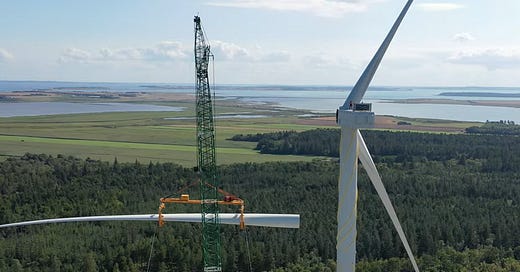In some recent posts talking about Wind Power and Women Power, I have been remembering some trail blazing women in sailboat racing. In a twist, this post is about using wind to make electricity – actual wind power.
The “energy transition”, the switch from old sources of power to renewable sources of power, is making some great progress that I rarely see in the media. Maybe the people clicking things want conflict so much that no one wants to write uplifting stories. Or maybe the overall climate story is getting so polarized that everyone stays away.
Regardless, onshore wind is now the cheapest way to make electricity: under $0.05 per kWh. It is even cheaper than hydro power – which historically has been the cheapest and the cleanest.
In 2019, the US Energy Information Administration reported that wind power exceeded hydro power as the largest generator of renewable energy in the United States for the first time. In the three years since, wind has grown by another 47 percent, from 295 to 435 terawatthours (tWh). Hyro has declined a bit, so next year, wind will likely be twice hydro, and closing in on nuclear at 778 tWh. Total utility scale electricity generation in the US is just over 4,100 tWh, so wind now generates 10% of the total (and nuclear + all renewables is now over 40%).
There are 72,669 wind turbines in the US Wind Turbine database with a rated capacity of 138,386 MW. Since 1990 wind turbines have grown from .5MW capacity each and about 100 meters in height to 15MW in capacity and over 300 meters tall. Each blade on a new wind turbine is now over 100 meters long.
Watching GE Renewables assemble one of these giants makes me grateful it is not windy every day!
GE Renewables is the largest manufacturer of wind turbines in the world. They put out a few press releases each month, but I had to go back to May of last year to find one about wind power in North America – and it was boring.
How are we going to spice this up?
Curious About Marketing Payment Policy
Curious About Marketing is a no cost* newsletter. It would seem like a bit of a waste for you to pay someone for this no cost* newsletter. So I don’t recommend it.
At some time in the future, I may change my mind and offer a paid version, or some additional features that would cost money. If so, I will change this statement at the bottom of each newsletter and clearly present the options.
You should feel comfortable forwarding this newsletter to anyone you think would like it.
Thank you very much for reading!
Sincerely yours, Jay
* this used to say FR**, but the use of the word FR** has landed this newsletter in some people’s spam folders. Or maybe FR** is a four letter word that starts with F? Anyway, thank you all for your patience as we figure out how to deliver the newsletter to you as friction fr** as possible.





